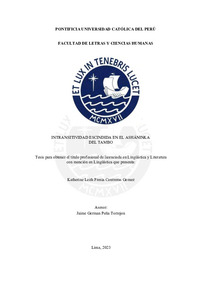| dc.contributor.advisor | Peña Torrejon, Jaime German | |
| dc.contributor.author | Contreras Gomez, Katherine Leith Fresia | |
| dc.date.accessioned | 2023-11-15T22:05:45Z | |
| dc.date.available | 2023-11-15T22:05:45Z | |
| dc.date.created | 2023 | |
| dc.date.issued | 2023-11-15 | |
| dc.identifier.uri | http://hdl.handle.net/20.500.12404/26454 | |
| dc.description.abstract | La presente tesis ofrece un estudio descriptivo del fenómeno de la intransitividad escindida en el
asháninka del Tambo (familia arawak) desde un acercamiento tipológico y funcional, en tanto nos
interesa hallar la correspondencia entre una estructura formal y su propósito comunicativo en el
mundo real (Hopper & Thompson 1980). Este último aspecto guarda un correlato significativo
con esquemas cognitivos que le permiten al ser humano categorizar la experiencia por medio del
lenguaje (DeLancey 1987). La intransitividad escindida consiste en la posibilidad de que el
argumento de una construcción intransitiva (S) se codifique en ciertos contextos como el
argumento más agentivo de una cláusula transitiva (A) y en otros, como el argumento más
pacientivo de esta misma (P). La intransitividad escindida que exhibe el asháninka del Tambo
presenta un condicionamiento discursivo a partir de la jerarquía de estatus de información en la
que se sitúan las cláusulas, especialmente, es relevante el estatus de pico narrativo (Jones & Jones
1979). Los datos de esta investigación provienen de habla natural y, en menor medida, de
elicitación, ya que la intransitividad escindida por motivación discursiva implica identificar
elementos novedosos de aquellos ya establecidos dentro de una narración o con distintos grados
de saliencia cognitiva. | es_ES |
| dc.description.abstract | The present thesis offers a descriptive study of the phenomenon of split intransitivity in Tambo
Asháninka (Arawak family) from a typological and functional approach, as we are interested in
finding the correspondence between a formal structure and its communicative purpose in the real
world (Hopper & Thompson 1980). The latter aspect has a significant correlate with cognitive
schemas that allow humans to categorize experience through language (DeLancey 1987). Split
intransitivity consists in the possibility that the argument of an intransitive construction (S) is
encoded in certain contexts as the most agentive argument of a transitive clause (A) and in others,
as the most pacientive argument of the same (P). The split intransitivity exhibited by Tambo
Asháninka presents a discourse conditioning from the hierarchy of information status in which the
clauses are placed, especially, the status of narrative peak is relevant (Jones & Jones 1979). The
data in this research come from natural speech and, to a lesser extent, from elicitation, since
intransitivity split by discursive motivation implies identifying novel elements from those already
established within a narrative or with different degrees of cognitive salience. | es_ES |
| dc.language.iso | spa | es_ES |
| dc.publisher | Pontificia Universidad Católica del Perú | es_ES |
| dc.rights | info:eu-repo/semantics/openAccess | es_ES |
| dc.rights.uri | http://creativecommons.org/licenses/by-nc-sa/2.5/pe/ | * |
| dc.subject | Lenguas indígenas--Perú | es_ES |
| dc.subject | Ashánincas | es_ES |
| dc.subject | Sintaxis | es_ES |
| dc.subject | Morfología | es_ES |
| dc.subject | Gramática | es_ES |
| dc.title | Intransitividad escindida en el asháninka del Tambo | es_ES |
| dc.type | info:eu-repo/semantics/bachelorThesis | es_ES |
| thesis.degree.name | Licenciado en Lingüística y Literatura con mención en Lingüística | es_ES |
| thesis.degree.level | Título Profesional | es_ES |
| thesis.degree.grantor | Pontificia Universidad Católica del Perú. Facultad de Letras y Ciencias Humanas | es_ES |
| thesis.degree.discipline | Lingüística y Literatura con mención en Lingüística | es_ES |
| renati.advisor.dni | 07536723 | |
| renati.advisor.orcid | https://orcid.org/0000-0002-3293-3935 | es_ES |
| renati.author.dni | 46162412 | |
| renati.discipline | 232996 | es_ES |
| renati.juror | Rodriguez Mondoñedo, Miguel Martin | es_ES |
| renati.juror | Peña Torrejon, Jaime German | es_ES |
| renati.juror | Zariquiey Biondi, Roberto Daniel | es_ES |
| renati.level | https://purl.org/pe-repo/renati/level#tituloProfesional | es_ES |
| renati.type | https://purl.org/pe-repo/renati/type#tesis | es_ES |
| dc.publisher.country | PE | es_ES |
| dc.subject.ocde | https://purl.org/pe-repo/ocde/ford#6.02.06 | es_ES |







